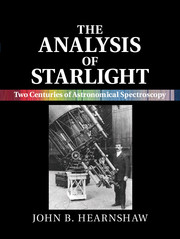
-
Select format
-
- Publisher:
- Cambridge University Press
- Publication date:
- April 2014
- March 2014
- ISBN:
- 9781139382779
- 9781107031746
- Dimensions:
- (253 x 203 mm)
- Weight & Pages:
- 1.1kg, 382 Pages
- Dimensions:
- Weight & Pages:
You may already have access via personal or institutional login
Book description
First published in 1986, this is the story of the analysis of starlight by astronomical spectroscopy. Beginning with Joseph Fraunhofer's discovery of spectral lines in the early nineteenth century, this new edition continues the story through to the year 2000. In addition to the key discoveries, it presents the cultural and social history of stellar astrophysics by introducing the leading astronomers and their struggles, triumphs and disagreements. Basic concepts in spectroscopy and spectral analysis are included, so both observational and theoretical aspects are described, in a non-mathematical framework. This new edition covers the final decades of the twentieth century, with its major advances in stellar astrophysics: the discovery of extrasolar planets, new classes of stars and the observation of the ultraviolet spectra of stars from satellites. The in-depth coverage makes it essential reading for graduate students working in stellar spectroscopy, professional and amateur astronomers, and historians of science.
Reviews
'… well-documented, beautifully written … an excellent historical summary and an invaluable resource for finding source material …'
Source: Choice
'Readers familiar with the 1986 octavo volume will be pleased with the illustrations’ improved quality. … Astronomers will likely welcome it as an encyclopaedic accomplishment.'
Barbara J. Becker Source: Isis
Contents
Metrics
Altmetric attention score
Full text views
Full text views help Loading metrics...
Loading metrics...
* Views captured on Cambridge Core between #date#. This data will be updated every 24 hours.
Usage data cannot currently be displayed.
Accessibility standard: Unknown
Why this information is here
This section outlines the accessibility features of this content - including support for screen readers, full keyboard navigation and high-contrast display options. This may not be relevant for you.
Accessibility Information
Accessibility compliance for the PDF of this book is currently unknown and may be updated in the future.


